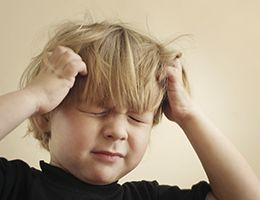Health library
Back to health libraryHeadaches in children: What parents need to know

There are many things you can do to prevent and treat headaches in your child.
Like skinned knees, headaches are an inevitable part of childhood. Sooner or later, just about every child gets at least a mild one.
Fortunately, when children do experience headaches, they're usually not a cause for alarm. Often, they're the result of something simple, such as a short-lived infection, too little sleep or a missed meal.
Only rarely are headaches a warning sign of a serious health problem, according to the American Academy of Pediatrics (AAP).
Even so, headaches can be so painful that they cause youngsters to miss school and keep them from playing with friends. There's reassuring news for headache-prone kids, though.
Headaches in children are often short-lived. And even for more severe headaches, good treatments do exist, according to the American Academy of Neurology.
What's wrong?
Often, children's headaches turn out to be primary headaches—headaches that develop by themselves, rather than from an illness or injury.
Generally, children have one of two types of primary headaches, though sometimes these two types are difficult to distinguish from each other:
Tension-type headaches. Children in the midst of one of these headaches may complain of a moderate, viselike pain, as though a rubber band were being squeezed around their heads, according to the AAP.
Migraines. These headaches are more severe and can be triggered by stress, a change in routine, bright lights, loud noises or certain foods. Often, the tendency to develop them is inherited.
Children often experience the throbbing pain of migraines on one side of the head, and it can worsen with activity.
That pain may be coupled with nausea, dizziness and extreme sensitivity to light or sounds. Some children have blurred vision or see colored or flashing lights minutes before their migraine pain starts—what doctors call an aura.
Heading off headaches
If your child is prone to headaches, it's important for you to know that they can often be prevented—with some simple steps, according to the AAP and other experts.
Be sure your child:
- Gets enough shut-eye. To stay headache-free, kids typically need 8 to 10 hours of sleep nightly. Sticking to a regular sleep schedule is also essential.
- Doesn't skip meals. Serve your child three daily meals at about the same time each day.
- Drinks enough water. That's especially important during hot weather or active play. Dehydration is a frequent headache trigger.
- Exercises regularly. Most children should get about 60 minutes of physical activity a day, including play.
- Has help coping with stress. Teach your child how to relax when headache-inducing tension builds. Encourage your child to take slow, deep breaths; to imagine a soothing image; or to unwind with a walk. Also help your child minimize stress—for instance, by eliminating activities from a crowded schedule.
- Avoids troublesome foods. In some kids, certain foods can trigger headaches. Common culprits include aged cheese, chocolate, caffeinated drinks, and foods preserved with nitrates (such as luncheon meats) or seasoned with MSG (monosodium glutamate).
Home treatments
If your child still gets a headache despite the above precautions, then what?
For the occasional mild headache, simple treatments that soothe your child may be the only care necessary, according to the AAP. You might try:
- Having your child nap in a quiet, darkened room.
- Giving your child a gentle head and neck massage.
- Offering your child a warm shower or bath.
- Applying an ice pack or a cool, wet cloth to your child's forehead.
Alternatively, you might give your child a nonprescription pain reliever (such as acetaminophen or ibuprofen).
When using over-the-counter medicines, take precautions. Be sure to read the medicine label to make sure you're giving your child the proper dose. Also, don't give your child these pain medications more than two or three times a week. Doing so can actually cause something called rebound headaches.
And never give aspirin to children or adolescents without a doctor's OK—doing so could cause a rare but life-threatening disorder called Reye's syndrome.
When to see a doctor
Some headaches do need a doctor's attention, especially frequent or severe ones. If you have questions or concerns about your child's headaches, call their primary care provider.
Expect your child's doctor to do a physical exam and take a detailed medical history to determine what's causing your child's headaches and the best way to treat them.
The treatment plan may include:
- Avoiding triggers. To identify potential headache triggers, you may want to keep a headache diary for your child. Your child's doctor can tell you more about this.
- Getting professional counseling if stress is contributing to headaches.
- Taking prescription medications. Some medications are available to ease headache pain. Other medicines may be tried to see if they will help stop frequent headaches from occurring in the first place.
Reviewed 8/20/2025
